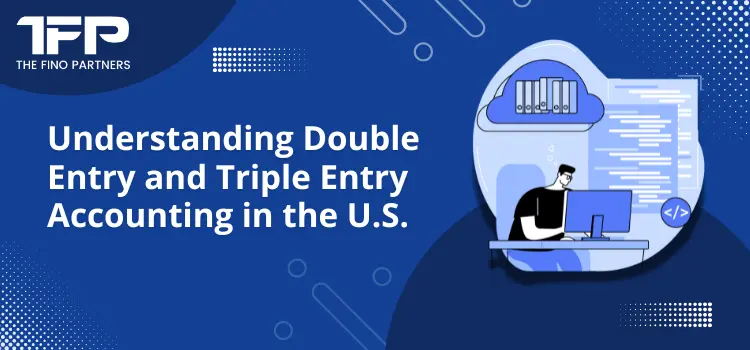Double-entry and triple-entry accounting are two methods of recording financial transactions. There are various accounting methods. A solid accounting system is necessary for the easy operation of a company. It is also needed for the organization of financial records.
Even when numerous accounting systems are available, double accounting methods have been used for decades. But, triple-entry accounting implementation has started gaining traction in recent years. After all, many business owners still get confused between the two when they opt for finance and accounting outsourcing. This article deals with double and triple-entry accounting in the U.S. Let's explore it.
Double-entry accounting
Double-entry accounting is a technique for documenting monetary transactions. It involves two accounts for each transaction. The transaction impacts two accounts at the same time. One account receives a credit, and the other receives- a debit.
It is because of the dual result. The double-entry system is precise. It adheres to generally accepted accounting rules where every transaction gets tracked. It gets tracked by a comprehensive interface. The process starts with the source documents and then moves to the ledger, journal, trial balance, and monetary record preparation.
Since this system allows for the out-and-out recording of financial transactions, there is less risk of embezzlement and fraud. As a result of the duality, unintentional mistakes can be easily identified. Also, accounts can be adjusted to correct them.
Top Benefits of Double-Entry Accounting
There are various benefits of double-entry accounting. It involves:
1. Reduces errors
The economic position of a company can be distorted- by human error. But, due to the checks and balances provided by double-entry bookkeeping, this is less likely. This is because the debit and credit amounts are equal in double-entry bookkeeping. Thus, errors are easily detected. After all errors are reduced, they do not get eliminated.
2. Creation paper trail
Double-entry bookkeeping lessens theft. It can be done by leaving an audit trail. You can use audit trails to monitor transactions posted to the general ledger. If your cash balance appears high on your balance sheet, you can monitor the transactions made to the cash account. It allows us to see if they are correct.
3. Making monetary statements
Businesses must produce accurate financial statements promptly. Management uses financial statements to determine many essential things. It involves how well their companies are performing financially. Double-entry bookkeeping transactions enable companies to prepare monetary statements easily.
4. Financial Control
Double-entry accounting provides greater financial control. It ensures the transaction is recorded in two accounts. It also provides a proper idea of financial health. After all, it helps companies to manage their finances better.
5. Completeness
The double-entry system helps to create a complete record of all monetary transactions. It involves the date, the amount, the account, etc. This data can be used to develop detailed monetary statements. This can be useful for business owners and investors.
Understanding Triple-Entry Accounting System
Most of the issues not included in double-entry accounting are dealt with using this method. Triple-entry accounting includes cryptographically securing all parties, included in the financial procedures. Triple-entry financial records are cryptographically enclosed and distributed. It makes them nearly impossible to destroy. A buyer notes a credit in the account for every dollar spent. Sellers record cash receipts as debits in two separate accounting books.
Blockchain technology solves this problem. It solves this by recording entries in the same shared database. This is a transfer between wallet addresses. That makes an interconnected network of permanent and objective accounting records. Instead of recording them differently in separate journals, Integrity, transparency, and auditing are just a few of the benefits of a triple accounting system.
Top Benefits of Triple-Entry Accounting
There are various benefits of double-entry accounting. It involves:
1. Distributed Authority
The authority no longer rests on one hand. This is as the data is transferred to all related hosts. Thus, data is consistent across businesses because everyone has equal access to it.
2. Precision
The chances of errors or misunderstandings between two parties are reduced. This is because the data stays connected to all the associated companies. As a result, data entry is more accurate regarding errors and omissions.
3. E-contracts
The e-contract software is programmed to work when all the required details are fulfilled. As a result, related actions are only carried out automatically. It will happen when a corresponding trigger approves them. More double-data-entry systems will be changed to triple-entry accounting. It is more reliable and advanced.
4. Improved Safety
One of the benefits of triple-entry accounting is improved safety. In the traditional double-entry system, transactions are recorded in two separate ledgers. In triple-entry accounting, a third ledger uses cryptography to save transaction information. It makes it nearly impossible for fraud to occur. It also helps protect against data breaches.
5. Improved Accountability
Triple-entry accounting helps to improve accountability. It will happen by providing a clear and transparent record of all transactions. It can be particularly important when there is a need for accountability. It involves government transactions or financial reporting for public companies.
Comparison between double-entry v/s triple-entry accounting
Every financial transaction is recorded in two different accounts. That is a debit to one account and a credit to another. Double-entry is one of today's most crucial accounting systems regarding virtual currency and blockchain-based.
The ledgers can be easily deceived since the adjustments are based on personal judgment. Human mistakes may be hard to recognize when payments are incorrectly noted. This adds a third component to the debit-and-credit accounting system in triple-entry. But, there is a slight misconception about this term. This is because it does not create a third entry.
But, it adds a third element known as the Bitcoin network with basic "blockchain" technology to the double-entry. It allows the link of every transaction element and primarily seals it. So it can never get changed or destroyed again.
This technology will revolutionize the accounting standard and establish a real-time ledger. It significantly reduces errors and fraud. After all, it makes an audit trail for every aspect of a transaction. This ground-breaking blockchain technology will secure information and communications in the accounting process. It also ensures complete transparency throughout the accounting procedures.
Closing Remarks
Double and triple-entry accounting have a set of pros and cons. Nevertheless, triple-entry accounting is gaining popularity amongst businesses due to its advanced blockchain technology. However, many companies and tax firms must fully understand its application and opt for finance and accounting outsourcing to streamline their company accounting.
Fino Partners provides high-grade accounting outsourcing services. It is given the immense industry expertise and vast pool of proficient CPAs and accountants. To learn more about our services, visit our website.



























